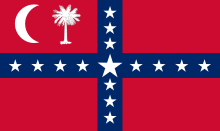Why pretend otherwise?
This was the reality of race-based slavery in the U.S. and elsewhere in the New World for centuries.
And, if, per the above picture, a whip was not deemed sufficient to control slaves, something almost medieval, like this adaptation of a cotton screw press, was another instrument of punishment, and an image and symbol of slavery.
But there are more.
I suggest going to this page of images from the University of Virginia for more "enlightenment" on images related to slavery. Since U.S. slavery was race-based, and from there went on to a belief in the mental inferiority of an invented "race" called black, these are all also symbols of racism.
But, they're not the only ones.
 This, too, is a symbol of slavery — the original Confederate battle flag at left. And, it didn't really appear out of nowhere — note its broad similarity to South Carolina's flag of secession, at right, and the rectangular version was proposed as a CSA flag.
This, too, is a symbol of slavery — the original Confederate battle flag at left. And, it didn't really appear out of nowhere — note its broad similarity to South Carolina's flag of secession, at right, and the rectangular version was proposed as a CSA flag.
The "St. Andrews Cross" or battle flag has 13 stars, for the 11 seceding states plus the attempts in Missouri and Kentucky; South Carolina's 15 are for all 1861 slave states.
This shows, first, that the Confederate battle flag, while created for battlefield visibility, and for more distinction from "Old Glory" than the original Confederate governmental flag, the "Stars and Bars," that it was already being adapted to politics early on. And, when it was decided to move on from the Stars and Bars, for a more Confederate-looking flag?
.svg/158px-Flag_of_the_Confederate_States_of_America_(1865).svg.png) This, "The Stainless Banner," incorporating the battle flag, became a symbol of racism on May 1, 1863. It was followed by "The Blood-Stained Banner" on March 4, 1865. (The Stainless Banner is an all-white union, if it's hard to tell.)
This, "The Stainless Banner," incorporating the battle flag, became a symbol of racism on May 1, 1863. It was followed by "The Blood-Stained Banner" on March 4, 1865. (The Stainless Banner is an all-white union, if it's hard to tell.)
Given that the constitution of the CSA, as well as documents of secession of several Confederate states (including Texas), explicitly mention slavery as a prime reason for secession, there you are.
And, that is seemingly that, is it not?
And, that is seemingly that, is it not?
Well, if you're the likes of William Lloyd Garrison, there were other symbols of racism. Ditto if you're a critic of some Supreme Court cases, like Plessy v. Ferguson. Or, of certain presidents, like Woodrow Wilson.
Indeed, Garrison called that symbol at right "a covenant with death" and "an agreement with hell." While hyperbolic, he's at least partially right, and it's not just the constitution itself. As Lincoln knew, and as this book and others document, the North had its own share of racism, and its own share of profit off Southern slavery.
None of this is to "excuse" the Confederate flag, in any of its forms. Or the racism behind it.
It is, though, to invite us to reflect on Lincoln's Second Inaugural Address, and his growth in recognizing that black people were people, even as he still had room to grow before his assassination.
Namely, this, reflecting on his version of "Divine Providence" affecting both sides in the Civil War. One need not be a theist to accept the broad outlines in this.
He now wills to remove, and that He gives to both North and South this terrible war as the woe due to those by whom the offense came, shall we discern therein any departure from those divine attributes which the believers in a living God always ascribe to Him? Fondly do we hope, fervently do we pray, that this mighty scourge of war may speedily pass away. Yet, if God wills that it continue until all the wealth piled by the bondsman's two hundred and fifty years of unrequited toil shall be sunk, and until every drop of blood drawn with the lash shall be paid by another drawn with the sword.
Just as Booker T. Washington called his autobiography "Up from Slavery," an "autobiography" of the US must be the same.
Speaking of such issues, whether Lincoln would have done THAT much better than Andrew Johnson on Reconstruction, I don't know. I do know it would have been impossible for him to do worse.
Speaking of such issues, whether Lincoln would have done THAT much better than Andrew Johnson on Reconstruction, I don't know. I do know it would have been impossible for him to do worse.

.svg/210px-Flag_of_the_Confederate_States_of_America_(1863-1865).svg.png)

No comments:
Post a Comment